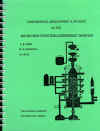|
Gasifiers are usually rated in kW (or Horsepower) of output, either kWth or kWel and vary from . If you have a large quantity of biomass (ie MSW) you might like a 100 ton/day unit which would yield about 20
MWthermal or about 4 MWel at 20% efficiency. Could cost you $10 Million (at $2000/kW capacity). These large gasifiers can be fixed bed (updraft or downdraft), fluidized bed, or even entrained feed
gasifiers.
I have written a number of articles and books on all aspects of gasification and you can get an overview of current activity from our book "Survey of Biomass Gasification - 2001" including the different gasifier types, who is making them, costs, addresses etc.
(see books). The "old testament" of small gasifiers is "Gengas: The Swedish Classic on Wood Fueled Vehicles". The "new testament" of small gasifiers is the "Biomass downdraft Gasifier Handbook", by T. Reed and A. Das.
I am very much dedicated to seeing gasifiers serve the needs of humanity, but most of the world can't afford to use large scale gasifiers and doesn't have a large supply, so there needs to be information on small gasifiers as well.
So, my personal specialty has been small gasifiers for power and transportation that I can make in my own small laboratory here in Golden Colorado. These small gasifiers are particularly useful and educational because they are easy to build, alter and study. From 1980-1986 we built and operated a 1 ton/day gasifier at the Solar Energy Research Institute, spending possibly $6 million for designers, fabricators, instrumentation engineers and rented space at Hazen Research here in Golden. Each institutional step could take days or weeks to complete.
| While waiting for the institutional wheels to grind, we took matters into our own hands and built a 5 gallon pail gasifier in the alley behind our laboratory. It had a blower and a flair, and we learned more about the basic science of gasification in that zero cost project than we learned from the $6 million project. All of this is described in our book "FUNDAMENTAL STUDY AND SCALE UP OF THE AIR-OXYGEN STRATIFIED DOWNDRAFT GASIFIER"
(see
Books). |
 |
One of our smallest gasifiers was used to investigate the relationship between the superficial velocity and the amount of charcoal and tar produced in the pyrolysis stage of gasification. It resulted in a paper,
"Superficial Velocity - The Key to Biomass
Gasification", which is one of the most fundamental studies of my long career and which informs my judgment on all gasifier design. The gasifier was only 30 cm tall and 5 cm inside diameter. The research was completed in less than a week (but took months to appreciate the importance).
Currently our smallest gasifier is incorporated in our WoodGas Cookstoves which we hope will eventually cook better meals for the 3 billion people now cooking substandard meals with too much fuel and smoke. The stove is only 15 cm tall and 12 cm in diameter and is ideal for camping or emergency cooking. We hope to build an even smaller gasifier for lighting.
|